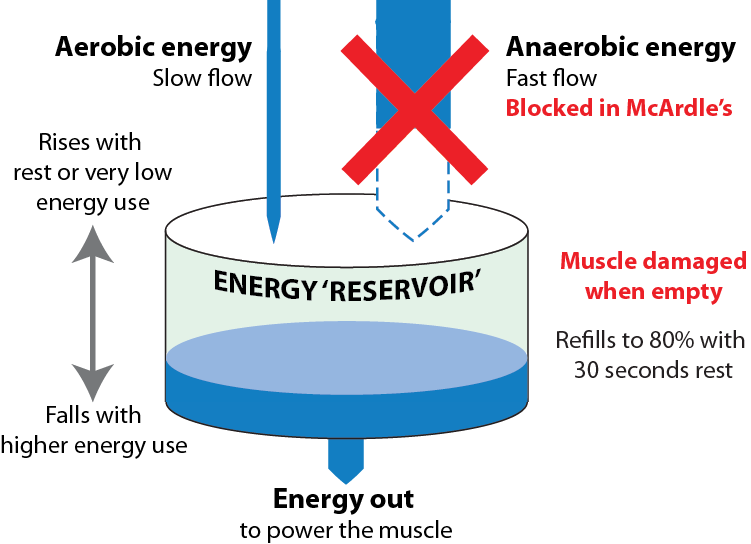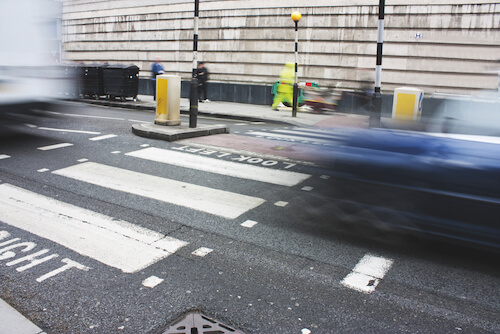In McArdle disease, building and maintaining a high level of aerobic fitness is essential. Here we introduce key aspects which can help you do just that.
Key concepts to help with safe and beneficial activity
There are several subjects which are key to managing well with our McArdle’s. They underlie many other tips which we can use to make our lives easier.
Here is a brief outline. These subjects are covered in the “101 Tips” book and in greater detail in the “Improving life with McArdle’s” booklet.
The way that our immediate energy reserve can run out is the most important concept to grasp.
Immediate energy reservoir
We have some immediately available energy (ATP and the phosphocreatine system) in the muscle cell and we can visualise this as a “reservoir”. The anaerobic and aerobic energy pathways are like two supply pipes bringing energy into the reservoir.
The anaerobic pipe is large and people without McArdle’s can very quickly turn this on to a full, fast flow. In McArdle’s that pipe is completely blocked. The aerobic pipe is smaller and slower flowing but works for us just like for everyone else.
When we exercise we take energy out of the reservoir. In order to not run out we have to ensure that the outflow is in balance with the supply. If the outflow is greater than the supply the energy level will drop, and if we keep going like that the energy will run out altogether and we start to break down the muscle.
An exercise test shows how heart rate reduces as we get into second wind. In real life we do not need to get such a dramatic initial rise.
“Second wind”
Second wind has been shown to be universal to all McArdle people, but some may need assistance to recognise it.
Normally in the first few minutes of exercise the muscles want to start using glycogen stored in the muscle. With McArdle’s we cannot convert that muscle glycogen to glucose in order to use it as fuel. So instead we have to use glucose and fat which are delivered to the muscles in the blood supply, but it is not enough. This shortage of fuel leads to muscle cramping and pain.
The graph shows how the heart rate (and pain) of someone with McArdle’s increases dramatically invthe early minutes of activity by comparison with an unaffected person. We have to avoid this by pacing ourselves.
After about 7 to 10 minutes of careful activity, our liver starts to release glucose from its store of glycogen, and fat is released from our fat stores. This switching to these fuel sources is us entering a “second wind”, a phase less difficult activity.
For any activity at maximal effort we must stop after 6 seconds or risk a contracture.
The “Six second rule”
When doing something at maximal effort, such as lifting a heavy object, rushing up a flight of stairs, or opening a new jam jar, the immediate energy “reservoir” is exhausted in about 5 to 10 seconds.
People unaffected by McArdle’s will start to make use of glycogen stored in the muscle, converting it to glucose for energy. However, in McArdle’s we can’t do that and so we risk a painful fixed contracture of the muscle which can last for hours or days.
To avoid damage it is a good idea to time six seconds by saying to yourself “One thousand, two thousand…” up to six. If the task is not completed by six, stop or put it down. Take a break, let the muscles recover for a minute and then maybe try again.

When we pause we need to wait 30 seconds to restore 80% of our energy reservoir.
“30 for 80”
Pain in McArdle’s lags behind the damage we do, so we need to learn to recognise the early signs and slow down or pause for a rest before we do any damage.
On recognising the need to pause, we should stop and count to 30 seconds – that is enough time to replenish 80% of the energy reservoir in our muscles. Then as we move on again we have some leeway and are unlikely to run out of energy again.
If we don’t time it, we are very tempted to move on again much too quickly and very quickly hit the same problem all over again.
For anything that might be risky, like crossing a road, first rest for 30 seconds.
“Rest before risk”
With McArdle’s we face risks of injury from running out of energy at a safety critical moment or in a critical situation. And we face risks of getting rhabdomyolysis (muscle breakdown) and needing hospitalisation. So when we are about to do something which might involve risk, like crossing the road, climbing a ladder or lifting something heavy, we should rest for at least 30 seconds before proceeding. This is to try to ensure that we have enough energy available to get us through the activity and past the risk.




